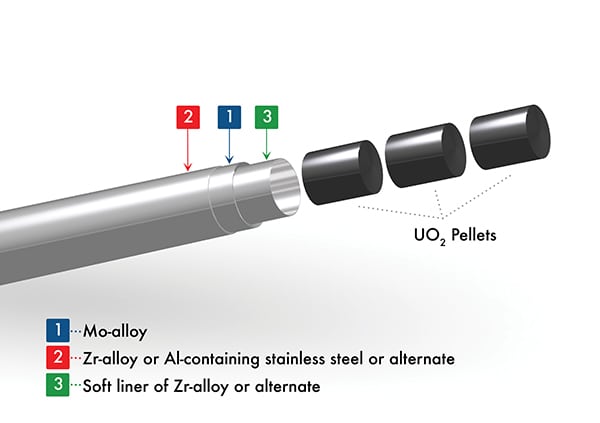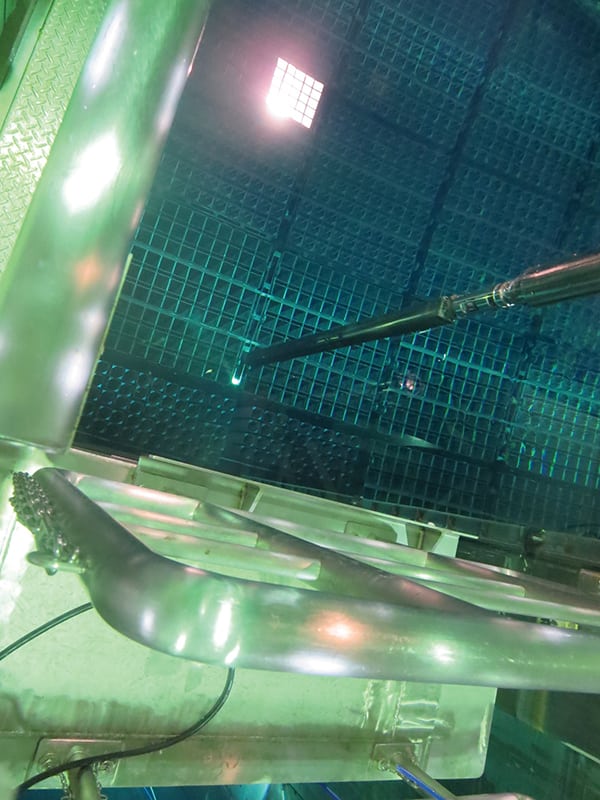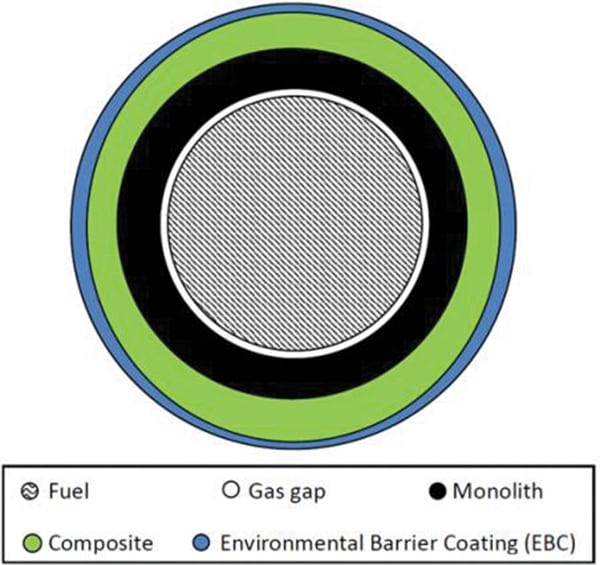Nuclear Industry Pursues New Fuel Designs and Technologies
Enriched uranium, the most commonly used fuel in commercial nuclear reactors worldwide, has many well-known advantages; however, recent events have underscored its disadvantages. Can new fuel technologies be developed and proven effective fast enough?
Late last year, Japanese engineers and technicians accomplished a major milestone nearly four years after the most damaging light-water reactor accident in history at the Fukushima Daiichi nuclear station. They removed the last of the undamaged fuel rods from the devastated Unit 4 reactor building, some 1,500 assemblies stored in a pool above the reactor (Figure 1). Hydrogen explosions shortly after the Mar. 11, 2011, earthquake and tsunami nearly destroyed that reactor, while it did destroy three others.
Removing the fuel from reactor 4 was the easiest task related to the radioactive fuel at the plant. Units 1, 2, and 3 suffered complete fuel meltdowns. The New York Times commented, "These reactors were so damaged-and their levels of radioactivity remain so high-that removing their fuel is expected to take decades. Some experts have said it may not be possible at all, and have called instead for simply encasing those reactors in a sarcophagus of thick concrete."
Among the advantages of nuclear power, fuel is one of the more important. Uranium packs a lot of punch and is widely available. Atomic power plants offset high capital costs with low fuel costs. But nuclear fuel presents big challenges because of the enormous amount of energy-and heat-packed into a small package. Even when nuclear fission stops, as happens in conventional light-water reactors during a loss-of-coolant accident, enormous heat remains. Nuclear fuel rods can melt, in the worst case into a glowing, radioactive blob in the bottom of the reactor vessel.
The Pros and Cons of Zirconium CladdingConventional fuel-enriched uranium oxide pellets in long rods encased in metal-offers the first line of defense in a reactor accident. Metal cladding housing the uranium is designed to protect the fuel's integrity while emergency cooling equipment removes residual heat. AREVA explains on its website, "Zirconium cladding is the reactor's primary safety barrier. Zirconium is the leading material for nuclear fuel assemblies used in light water reactors" because it is transparent to neutrons, it has good temperature performance, and it withstands corrosion."
But experience has shown, first at Three Mile Island (TMI) near Harrisburg, Pa., in 1979 and again, in spades, at Fukushima, that this first line of defense can fail.
At TMI, as the events of a small loss-of-coolant accident progressed, General Public Utilities operators were confident that the fuel would not melt. As fuel damage became obvious, plant officials consistently underestimated the extent of the damage. According to the written material accompanying the TMI exhibit at the Smithsonian Institution's Museum of American History, plant officials always took an optimistic view when trying to understand the unfolding picture of the fuel damage. In the end, it was clear that a majority of the fuel had melted down and the accident completely destroyed the core. Yet, the conventional wisdom about the accident is that the reactor experienced a euphemistic "partial meltdown," because less than 100% of the fuel melted.
At Fukushima, there is no challenge to the observation that the three reactors suffered complete fuel melting. But that may not have been the worst event in the accident. A 2013 news release from the Massachusetts Institute of Technology (MIT) observes that the zirconium alloy cladding of the Fukushima fuel played a major role in the events at the multi-reactor site. Noting the series of spectacular hydrogen explosions at the site, the MIT release says that "hydrogen buildup was the result of hot steam coming into contact with overheated nuclear fuel rods covered by a cladding of zirconium alloy, or 'zircaloy'-the material used as fuel-rod cladding in all water-cooled nuclear reactors, which constitute more than 90 percent of the world's power reactors. When it gets hot enough, zircaloy reacts with steam to produce hydrogen, a hazard in any loss-of-coolant nuclear accident."
The Hunt for New Fuel Assembly OptionsMIT researchers are working on a ceramic cladding for enriched uranium fuel pellets to offer characteristics similar to zircaloy while reducing the risks of hydrogen evolution "by roughly a thousandfold." MIT's focus is on silicon carbide (SiC). Mujid Kazimi, the TEPCO (Tokyo Electric Power Co., owner and operator of the Daiichi plant) professor of nuclear engineering at MIT, who is leading the research team, said, "We are looking at all sides of the issue, regarding replacing the metal cladding with ceramic." SiC, he says, is "very promising, but not at the moment ready for adoption" (Figure 2).
According to Kazimi, SiC cladding has potential advantages beyond reducing accident risks. Because it reacts slowly with water, says Kazimi, under normal conditions, SiC should degrade less and remain in the core longer than zircaloy, allowing operators to squeeze extra energy out of the rods before refueling. That would also reduce the amount of spent fuel produced by the reactor.
Other industry teams are also looking at ways to increase the accident tolerance of reactor fuels. Last fall, an AREVA-led team including the Tennessee Valley Authority, Duke Energy, the universities of Wisconsin and Florida, and the Department of Energy's (DOE's) Savannah River National Laboratory won a DOE contract to examine technologies to increase the tolerance of reactor fuel to loss-of-coolant accidents. In a press release, AREVA said the researchers are focusing on "coatings on the zirconium cladding, additives to the uranium pellets as well as modifications to the coolant loop." AREVA said it hopes to launch tests in commercial reactors in 2022.
The Electric Power Research Institute (EPRI) in 2011, responding directly to Fukushima, started a program to examine "fuel technology innovations for improving nuclear plant safety by reducing hydrogen generation and preventing core meltdown during severe loss-of-coolant accidents." EPRI is focusing on molybdenum (Mo) as "a potential breakthrough for meeting performance targets during normal operations while maintaining fuel integrity at temperatures exceeding 1500C." EPRI says it is working on proof-of-concept of dual cladding with "thin-wall Mo tubes coated with oxidation-resistant layers of either zirconium alloy or aluminum-coated stainless steel," as well as a three-layer design (Figure 3). EPRI says it hopes to expose the new fuel assemblies to radiation this year, "supporting in-plant demonstration within a decade."
 |
| 3. Adding Mo protection.Fuel cladding incorporating molybdenum (Mo) offers one potential technological pathway toward accident-tolerant nuclear fuel concepts. Courtesy: EPRI |
The DOE is supporting multiple research projects on new ways to clad fuel, because of the safety advantages and for the prospect of extended burnup of the fuel. The DOE's nuclear energy program has been looking at ways to extend fuel life in reactors for over 20 years. A 2008 paper in Nuclear Engineering and Technology described obstacles in extending the life of conventional reactor fuel, which has a useful life of around four years before removal from the reactor. The article said, "To stay competitive the industry needs to reduce maintenance and fuel cycle costs, while enhancing safety features. Extended burnup is one of the methods applied to meet these objectives. However, there are a number of potential fuel failure causes related to increased burnup." All of those are related to problems with zircaloy cladding.
Apparently, some small progress is being made. In January, Westinghouse announced that its next-generation fuel, called CE16NGF-the CE is for the Combustion Engineering pressurized water reactor (PWR) fleet-would be used at Arizona Public Service's Palo Verde Nuclear Generating Station. It has also been used at two other U.S. sites. Westinghouse, which is a single-source global fuel provider for PWRs, says the new fuel "incorporates proprietary materials, such as advanced cladding material and burnable absorbers, and advances in structural design that improve the fuel's efficiency and reliability while also increasing its service life. CE16NGF provides improved economic performance and greater operational flexibility in fuel duty, thermal margin and uprate capability."
Alternatives to Conventional TechnologiesAs researchers examine ways to make conventional nuclear fuel safer and more economical, on a longer time scale, other scientists are looking at ways to move away from light-water reactor technology and the current fuel cycle. In the U.S., the focus of this work has been at the DOE's Idaho National Laboratory, traditionally the place where new reactor designs have been tested, going back to 1951, and at the DOE's Argonne National Laboratory near Chicago, where reactors have long been conceived and designed.
Argonne's Mark Peters told The New York Times, "There's a whole class of reactor that are not evolutionary concepts relative to what you have out there now-they're really different." While there's no market for these designs today, that could change in 30 years or so. "In a carbon-constrained world," said Peters, "with that time frame, you better have some advanced reactors ready to go." (For a look at reactor designs under development, see "THE BIG PICTURE: Advanced Fission" in the November 2012 issue or at powermag.com.)
Most of these advanced concepts are not exactly new. Nuclear researchers have long looked at liquid sodium as a reactor coolant, because sodium has attractive characteristics, including excellent heat transfer, a low melting point, and a high boiling temperature. Using sodium coolant could provide extended fuel burnup. But sodium is inherently dangerous, capable of burning or exploding when exposed to water or air.
GE has put many years and millions of dollars into its PRISM sodium-cooled, fast neutron reactor design. TerraPower, a company with financial backing from Microsoft founder Bill Gates, is designing a sodium-cooled "traveling wave reactor" using depleted uranium (U-238 left after enrichment has removed much of the fissionable U-235), optimistically projecting commercialization in "the late 2020s."
There is also widespread work on developing a fuel cycle based on the naturally occurring element thorium. Bombarding thorium with neutrons can transmute the element into U-233, which does not occur in nature and is fissile. The late nuclear energy pioneer Alvin Weinberg long advocated thorium reactors, because they cannot melt down and do not produce plutonium, used in weapons. The Atomic Energy Commission experimented with thorium reactors in the 1960s, but the technology lost out to light-water reactors, as also occurred with sodium-cooled reactors.
Thorium has its own set of inherent technical and economic problems, among them the need to reprocess the irradiated thorium to get the U-233. A 2012 article in the Bulletin of the Atomic Scientists claimed that a thorium fuel cycle would be considerably more expensive than the current uranium fuel cycle and would "require too great an investment and provide no clear payoff."
Research into the thorium fuel cycle continues. India has the most ambitious program. India refused to sign the 1968 Nuclear Non-Proliferation Treaty and exploded its own atomic bomb in 1974, largely cutting itself off from international assistance in developing a nuclear power program. The country has little indigenous uranium but lots of thorium. That led India to explore a thorium fuel cycle. The country is now getting international assistance for conventional light-water reactors, but its interest in thorium has not waned.
According to World Nuclear News, India is building a 500-MW prototype thorium reactor, expected to be in operation this year. This step, said the publication, will "set the scene for eventual full utilization of the country's abundant thorium to fuel reactors. Six more such 500-MWe fast reactors have been announced for construction, four of them by 2020."
Less-ambitious thorium research and development (R&D) efforts are under way in Canada, China, Germany, Israel, Japan, Norway, the UK, and the U.S. An article in The Economist a year ago breathlessly touted the thorium fuel cycle's advantages as if they were newly discovered. U.S. interest is reportedly at a very low level at the DOE. Sens. Harry Reid (D-Nev.) and Orrin Hatch (R-Utah) have pushed to revive the government's research into the liquid fluoride thorium reactor, abandoned in the 1960s because it lacked a military connection. Reid and Hatch have repeatedly introduced legislation to revitalize thorium R&D. Congress has shown no interest so far. a-
- Kennedy Maize is a POWER contributing editor.
The post Nuclear Industry Pursues New Fuel Designs and Technologies appeared first on POWER Magazine.

